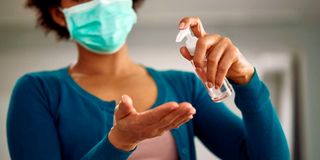It hasn’t only been doom and gloom with coronavirus

What you need to know:
- Curfews, lockdowns and closure of pubs and clubs resulted in almost zero traffic accidents, trauma and assaults, while the cut-back in air pollution hugely contributed to reduction in disease burden.
- The cut-back on provision of non-emergency care also meant less patients coming to hospital.
This month we mark 24 months since the Covid-19 pandemic was first reported in Kenya. It has been two long years of fear, anxiety, loss, and pain but time has heralded a new dawn of hope, recovery and rebuilding. We have come a long way, from the morbid fear of sneezing in public for fear of being labelled, to restoring almost normal human interaction. The downside of the pandemic bit hard, with illness, loss of life, a crashing economy, job losses and loss of income for many. Our health system struggled to contain the effects of the pandemic amid shortages of health commodities, wanton corruption and misappropriation of the scarce resources sorely needed.
Inadvertently, while we focused on containing the spread of Sars-Cov-2, we ignored other essential areas. Scaling down of health services and fear of visiting hospitals grossly affected chronic illness management, especially for cancer patients. Missing scheduled chemotherapy and radiotherapy sessions caused poor outcomes. HIV care took a hit as patients lived through drug shortages that posed a real threat to their lives.
Patients with asthma, diabetes, hypertension, heart disease and sickle cell anaemia among others, were unable to access routine care, hence missed out on early detection and management of complications. Many died in their beds at night due to lack of access to transport to hospital. Access to reproductive health services was also hampered. Now, we celebrate our Covid-19 babies when contraceptive access was impossible!
Meanwhile, private health insurance providers were having a field day. Throughout the curfew period, medical claims plummeted massively. Children staying home from school markedly eased transmission of common infections, especially respiratory infections. Curfews, lockdowns and closure of pubs and clubs resulted in almost zero traffic accidents, trauma and assaults, while the cut-back in air pollution hugely contributed to reduction in disease burden. The cut-back on provision of non-emergency care also meant less patients coming to hospital.
As a result, the need for health services drastically reduced, resulting in a huge reduction in claims to insurers. For once, they were able to make massive profits from both health and motor vehicle insurance.
The downside now is that many insurers aren’t handling the return to normalcy well, and both the insured and the contracted service providers are paying the price!
The initial scramble for personal protective equipment caused an esoteric rise in cost of medical consumables. The price of gloves, for instance, was up 1,000 per cent for months. Despite the worldwide shortages easing off, the cost remains at least 300 per cent higher than before.
In addition, the requirement to wear face masks for all means that all health workers have to wear medical grade disposable masks at work. This was unlike before when the masks were only required in the operating theatres and procedure rooms. The cost of masks still remains at least thrice as high as it was before. Unfortunately, these costs are passed on to the patient directly, culminating in an increase in the cost of healthcare.
Despite the tough times, all hasn’t been gloom and doom. We must admit that many Kenyans are much more aware of health matters. The handwashing messages have resulted in increased awareness towards personal hygiene and sanitation and we now have a whole generation of children with better hand hygiene practices. The perpetual conversations regarding the pandemic have made people a lot more aware of health matters. This has given rise to individuals practising self-care, actively embracing healthy lifestyles, preventive and promotive health practices and becoming better involved in decision-making regarding their own health. In addition, telemedicine, which had lagged behind in Kenya, received a great boost.
Health workers are also a lot more alert to their own vulnerabilities at the workplace. They are a lot more conscious of their own safety in the workplace and their limitations within their practice. This has opened the door for acquisition of knowledge through multiple online platforms providing continuous medical education.
Learning is more affordable, convenient and accessible as many universities and colleges embrace remote teaching; enabling more health workers to study within their chaotic work schedules. This is a win for both the provider and their patients!
Dr Bosire is an obstetrician/gynaecologist



